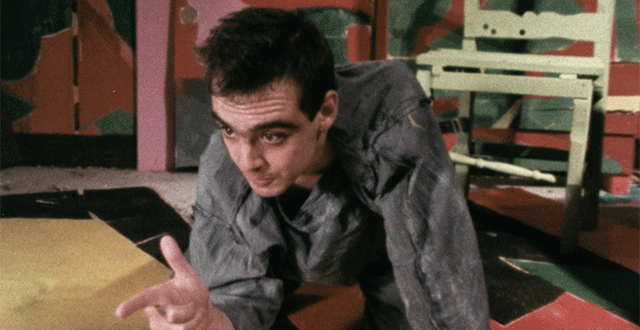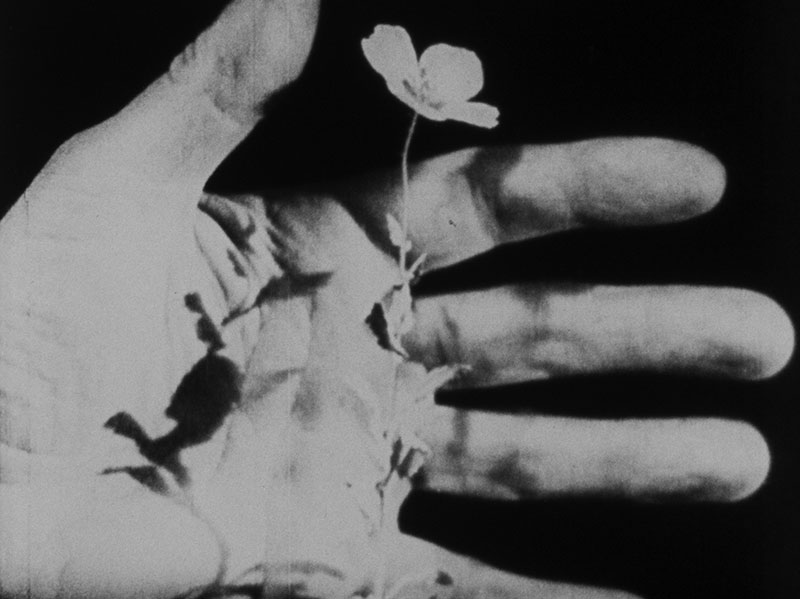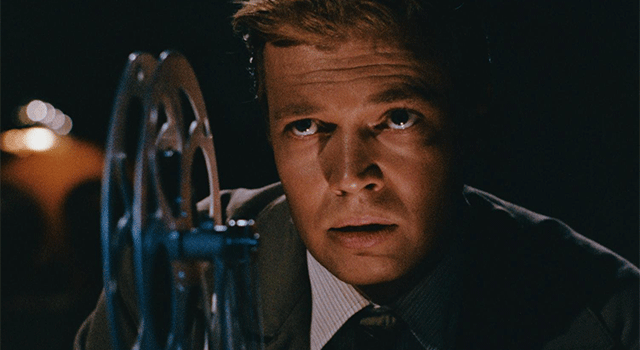If you associate Michael Powell with lush Technicolor dreams or spirited love stories and adventures, then Peeping Tom (1960) will undoubtedly come as a shock. Made three years after he and Emeric Pressburger parted company, Powell’s portrait of a serial killer stars Karlheinz Böhm as the young cameraman who murders women with the sharpened end of his tripod while capturing their agonised final moments on film. The way Powell implicates the viewers’ own voyeurism makes it a uniquely disturbing and provocative experience.
When critics saw Peeping Tom, the response was instant and vitriolic. The film was an aberration, a stain on the reputation of its great director, and the best thing for everyone would be for it to be disposed of and forgotten as quickly as possible. As Michael Powell wrote in his memoirs, the film’s producers gave the critics what they wanted: “They yanked the film from the Plaza, they cancelled the British distribution, and they sold the negative to an obscure black-marketeer of films who tried to forget it, and forgotten it was, along with its director, for twenty years.”
Thankfully, Powell lived to see the critical tide turn on Peeping Tom, and in the years since the director’s death in 1990, its reputation has continued to grow, as has much of Powell and Pressburger’s body of work, thanks in part to the ongoing promotion and restorations undertaken by his friend and admirer Martin Scorsese and Powell’s widow Thelma Schoonmaker. It was Scorsese who spearheaded the rediscovery of Peeping Tom, getting it screened to wide acclaim at the New York Film Festival in 1979 and re-released the following year. He brought Powell over to share in the new reactions to the film, paying for the flight to New York, which Powell couldn’t otherwise have afforded.

“To create anything, whether it’s writing or painting or music or dance or cinema, you have to be obsessed,” says Scorsese. “But one can cross the line into danger, easily. Michael Powell didn’t just understand that danger – he lived it. And he actually expressed it in cinematic terms.
“Unlike The Red Shoes, set in the grand world of high culture, Peeping Tom is set at the rock bottom level of low culture, with a protagonist who has already crossed the line. On a plot level, it’s about a serial killer who murders women as he films them. On a deeper level, it’s a portrait of self-destruction by means of cinema – the lenses are scalpels, the splices real cuts that bleed, the celluloid razor wire, and the light of the projector blinding.”
This year, Peeping Tom will be back in the spotlight with a new 4K restoration by The Film Foundation and the BFI National Archive in association with StudioCanal. Ahead of its premiere at the London Film Festival, I spoke to some of the other key players involved in the restoration to find out what goes into such a project.
Beginning
“The restoration programme is an ongoing, rolling thing, but we will identify in any given year a core list of prestige titles that we want to restore,” John Rodden of StudioCanal tells me. Rodden is the head of Library and Home Entertainment at the company, which owns the rights to Peeping Tom and, along with The Film Foundation, has funded this restoration. “Sometimes it is partner-driven, sometimes we know that there is an anniversary coming up, which is always a good occasion to revisit a film. In this case, the BFI is doing a Powell and Pressburger season and that’s something where we can work together and find a suitable date to do the restoration and have an occasion to centre the release around. You have to find a hook, and theatrical releases give us that scope because you can have people revisit the film editorially.”

Once a title has been greenlit, StudioCanal’s head of technical services, Stephen Hill, retrieves whatever materials they hold in the vaults. For Peeping Tom, they scanned the original Eastmancolor negative at 6K to produce uncompressed DPX files, before being down-sampled to 4K for the restoration work. This scan was done on an ARRI XT by the UK-based company Silver Salt Restoration, but before that could happen the negative itself needed a lot of treatment.
“We had to do some work before we scanned it, fixing some of the joins and perforations to make sure it was smooth and wasn’t going to break on the machine,” Hill explains. “Once we had scanned all of that, we sent it on to our partners at Cineric who were commissioned by The Film Foundation to do their part in New York. When they got the scan, they came back and said some parts of it gave them trouble and had too many scratches, so we then employed something called a wet gate, where liquid goes across the negative and allows us to scan it more smoothly to make their job easier. In the end, if you get that first part of the restoration correct, it makes a world of difference.”
Picture
The picture restoration took place at Cineric in New York, which has a longtime relationship with Scorsese and Schoonmaker through their work on previous Film Foundation restorations. The project was supervised by technical director Simon Lund, who spoke to me alongside Cineric’s digital film restoration supervisor Seth Berkowitz. “There was a lot of stabilisation and the usual dust and dirt, but because it wasn’t that faded, I didn’t have to do a tonne of de-flicker like I might on a lot of jobs,” Berkowitz says. “It’s a blend of automated processes and then a manual review and touch-up on a shot-by-shot basis, but then it comes down to a frame-by-frame basis. We do want to remove all the defects, but we don’t want to do anything to the image that would make it less filmic; it should still have an organic feel to it. That can take a couple of months.”

When the image has been restored to everyone’s satisfaction, Cineric’s grader Daniel DeVincent comes into the project to fine-tune the colour, a process in which he works closely with Scorsese and Schoonmaker. “There was a reference print made from the original negative somewhere in the last 15 years, so that’s very helpful to get the look that it would have had coming off the negative. I will also usually have any reference video previously done, and Thelma Schoonmaker did have some involvement with the previous transfer. We did some grading tests that went to Marty Scorsese and Thelma. As Powell is one of Scorsese’s favourite directors he had very strong feelings about how he thinks Peeping Tom should look. So I was able to get more feedback on this title than I normally get on most colour grading projects.”
Sound
While Cineric worked on the image, the sound was restored by Helen Miles at Molinare in London, working alongside the BFI National Archive’s team. After Mike Kohler from the BFI National Archive brought together all the three optical tracks that the BFI and StudioCanal held, they were scanned and pulled into Pro Tools for Miles to begin her work. “We painstakingly work through and take out any residual distortion, pops and clicks from dust damage, cuts where you get little clunks at the tape joins, that sort of thing. We’re looking at bringing the film to a modern audience and getting rid of anything that doesn’t do service to the film, essentially.”
Working on the sound also means finding the right balance, and making judgement calls on audio dynamics that may seem jarring to an audience seeing the film for the first time today. “The whole track of Peeping Tom is quite sparse,” says the BFI’s head of conservation Kieron Webb. “Occasionally they’re moving about the set and you hear squeaks on the floor, but then you get this very loud stabbing piano or the police sirens, which are almost unbearably loud. But if you soften the impact of that you’re losing the creative intention of that dynamic jump.”
Miles also points to Powell’s use of sound in the protagonist’s dark room as an example. “In the dark room there’s this very ominous drip that to a modern audience feels quite heavy-handed, but it helps make it feel different from the rest of the house and where he works and so on. You have this party scene downstairs, it’s busy and lively, and upstairs it’s a troll cave, and the addition of that one sound effect makes it very atmospheric and eerie. It might seem heavy-handed, but it does the trick.”
Release
The new 4K DCP of Peeping Tom will receive its world premiere at the London Film Festival on 7 October and will be released in UK cinemas on 27 October and as a special edition UHD, Blu-ray and DVD release on 29 January. It will also play as part of the BFI’s Cinema Unbound: The Creative Worlds of Powell and Pressburger season at BFI Southbank and UK-wide programme (16 October to 31 December) and at the Lumière Film Festival in Lyon (14 to 22 October). Beyond that, Rodden says: “Eventually we will have it on our StudioCanal Presents channel as well, but we encourage people to see it in the cinema in the first instance. It’s such an important film in the context of Michael Powell’s personal journey through cinema, and over time a continuing fascination has grown with the film.”
“There’s no other picture quite like Peeping Tom in the history of the cinema,” says Scorsese. “It is ravishingly beautiful, like all of Michael’s greatest films, and I’m thrilled that we’ve finally been able to give it the restoration that it deserved. It is also a shock to the system, a deeply unsettling, and, I find, absolutely lucid picture about the danger of making art.”
Cinema Unbound: The Creative Worlds of Powell and Pressburger runs from 16 October to 31 December.







